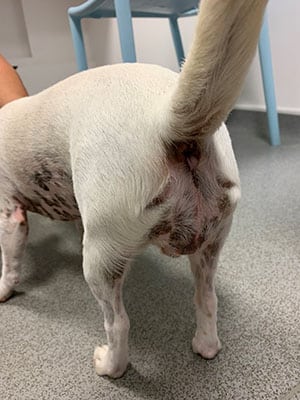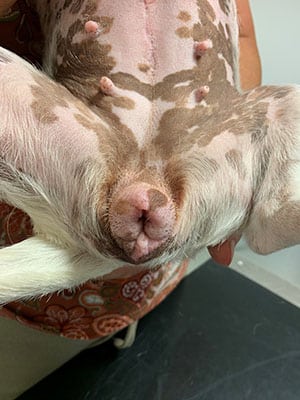
We have recently seen an alarming spike in the number of cases of dogs who have come into contact with hormonal cream containing oestrogen (HRT) for use by humans. Since the start of the year we have diagnosed five dogs with secondary exposure to HRT.
HRT is widely used to relieve the symptoms of the menopause and applying it through a skin patch, gel or cream, instead of orally, are increasingly popular ways to administer it.

Hospital Director Gerry Polton said: “According to the NHS, there has been a 35 per cent increase in the number of HRT items prescribed between 2020/21 to 2021/22.
“With the increasing use of HRT products we suspect secondary oestrogen exposure in pets may be occurring with increased frequency nationally.”
Recently, we were presented with a three-year-old female neutered Jack Russell Terrier called Rosie who displayed typical symptoms of HRT secondary exposure, including increased sexual attractiveness to male dogs, vulval enlargement and hair loss.
Rosie’s owner, Sue Burgess, from Hove, said: “Rosie had been spayed in October 2021 with no complications, so we were mystified to see her apparent ‘season’.
“When we met with NDSR they revealed their suspicions which made complete sense to us. I had started Gel HRT about six weeks before Rosie showed symptoms.
“Since the change in my HRT routine we have seen a very slow change in Rosie. She does not ‘attract’ the males now, her vulva is slowly reducing, and she is fussing less.”

Gerry added: “Secondary HRT exposure to animals typically occurs through exposure to gels and creams applied to their owners’ forearms, a recommended site of application according to product data sheets.
“We would urge dog owners using HRT in this manner to be aware of the possibility of secondary exposure to their pets. It is thought that this most commonly occurs by skin-to-skin contact, perhaps most likely through the less haired areas of pets, like the belly.
“Most cases of secondary oestrogen exposure can be treated simply, by ensuring no further contact with the oestrogen source, in which case exposure signs should disappear within months, albeit hair regrowth may take up to six months.
“It is, however, important to be aware that more serious adverse events, such as bone marrow suppression, can be seen with oestrogen exposure, which may be irreversible and ultimately fatal. Fortunately, we have yet to see this as a result of secondary exposure to HRT products at NDSR though.”
Case Advice or Arranging a Referral
If you are a veterinary professional and would like to discuss a case with one of our team, or require pre-referral advice about a patient, please call 01883 741449. Alternatively, to refer a case, please use the online referral form